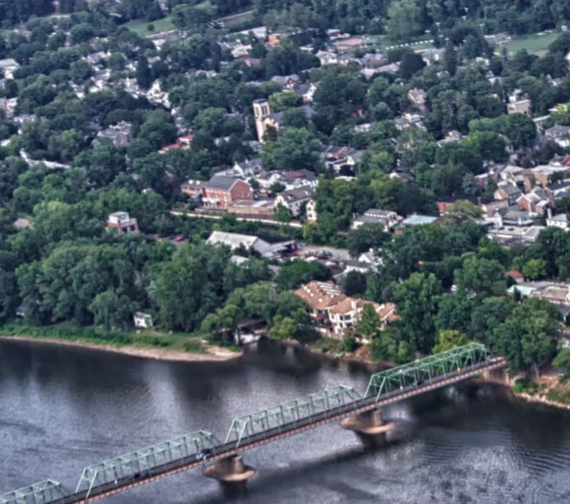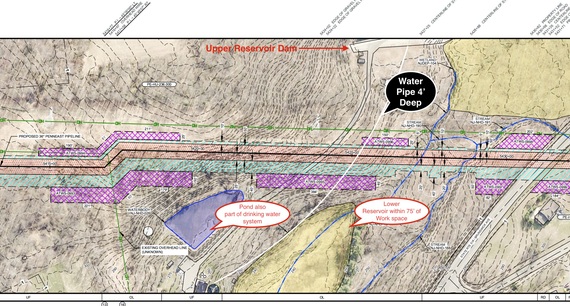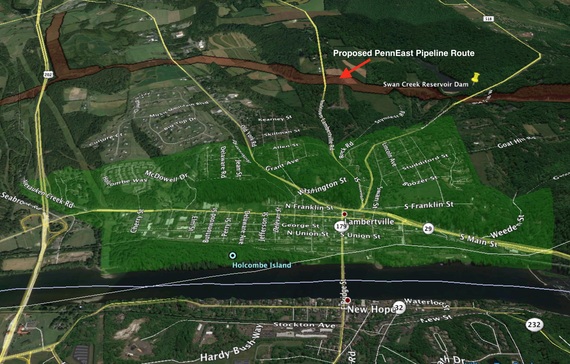By Mike Spille
In August, 2014, a consortium of 6 companies including utility giants Houston-based Spectra Energies, UGI Energy Services, Atlanta-based AGL Resources, Long Island-based Public Service Enterprise Group, South Jersey Industries (SJI Midstream), and New Jersey Resources Pipeline Company, operating as the PennEast Pipeline Company, LLC, announced their plans to build a 36-inch, three-foot diameter pipeline to transport fracked gas from the Marcellus Shale region in Pennsylvania into New Jersey.
On its 108 mile journey to a connector station just outside Princeton, the PennEast pipeline would tunnel beneath the Delaware River, cross open space, pass through organic farms, a township solar field, historic districts, tax-payer preserved open space, wetlands, and pristine C-1 streams.
For almost two years, people have been asking, "Where the heck is Lambertville?"
In August, Lambertville awoke when they learned that the pipeline not only threatened to cut through the reservoir's water pipe, but also that PennEast would be blasting within feet of the reservoir itself, threatening to cut off the town's water supply.
They've swiftly joined their neighbors to fight a pipeline project that senators, congressmen and women, and experts have deemed dangerous and unneeded.
But, the question remains. Is it too late for Lambertville?
A River Town Pulls Into its Shell
Lambertville, settled in 1705, is one of the oldest communities in New Jersey and perches along the banks of Delaware River an hour north of Philadelphia. The town has been described by the thousands of tourists who visit every year as "timeless, charming, an old-style River Town." One popular eatery on Bridge Street, Sneddon's Luncheonette, only opens for breakfast and dinner. Neighbors have been gathering there for generations to shoot the breeze. Another more upscale establishment, The Full Moon Cafe, serves dinner - but, as you might guess from its name - only once a month, during the full moon.
Antique stores abound on the main drag. At end of Bridge Street, couples pose for pictures against a backdrop of tree-covered hills, bordering the wide river, or hike and bike along the historic Delaware & Raritan Canal State Park, which parallels the river from Washington's Crossing all the way to Frenchtown 29 miles to the north.
While most of Hunterdon County, of which Lambertville is a part, is staunchly Republican, Lambertville has remained Democratic. The first gay marriage in New Jersey was officiated by Mayor David DelVeccio in 2013, and Lambertville sponsors one of the biggest annual Gay Pride celebrations in the area. The city was also one of the few Hunterdon County towns to vote for Obama in the 2008 and 2012 elections.
Many people expected Lambertville to lead the charge against a pipeline that would certainly disrupt the much-needed tourist trade.
But, Lambertville never really got involved in the fight. There was an initial strong surge against the PennEast Pipeline, led by the New Jersey Sierra Club, but that surge disappeared as quickly as it rose.
"I live here in Lambertville and know many of the residents personally," says NJ Sierra Club Director Jeff Tittel. "With its strong activist core, Lambertville became a very good place to start our fight against the proposed pipeline. We have around 150 Sierra Club members in Lambertville alone."
On October 21, 2014, at the urging of the Sierra Club and others, the City of Lambertville passed a resolution opposing the PennEast Pipeline consortium and forwarded that resolution to the federal government.
"After that initial surge, the town lost interest," says Tittel. "Most of the people in Lambertville saw the pipeline going west of us and the pipeline drifted out of the city's consciousness."
Communities Surrounding Lambertville Organize
Residents in the Hunterdon and Mercer County, home of Princeton University, have become educated in the Marcellus Shale, how gas is fracked, and how pipeline systems work, not only locally, but nationally. They've sent thousands of comments of opposition to the Federal Energy Regulatory Commission in charge of the PennEast permitting process. They've hired experts, written letters to the Editors, spoken in press conferences and at events. They've attended federal scoping meetings, taken time off from work to educate themselves and their neighbors. The opposition from those towns and their officials is as vigorous as it was two years ago and by all standards astounding in its tenacity.
Some people believed that Lambertville remained silent because the proposed pipeline route was located several miles away from them; and, therefore, had become someone else's problem.
That notion was tested in January, 2015, when the PennEast Pipeline company changed its route putting the pipeline just 1,000 feet outside of the city limits. And, most notably, the new route was very close to the Swan Creek Reservoir, which provides drinking water for the majority of Lambertville residents. Surely now Lambertville would get involved.
Although, neighboring towns, activists and organizations tried to alert Lambertville to the threat, emails and phone calls went unreturned. People came back shaking their heads, asking themselves why there simply was no interest or concern about something to crucial to the city's financial wellbeing.
In September 2015, PennEast filed officially with the Federal Energy Regulatory Commission (FERC). On July 22nd, 2016, FERC responded with a Draft Environmental Impact Statement (DEIS) that looked favorably on the project. The DEIS concluded that construction and operation of the pipeline would have minimal impact to the environment. As part of the review process of the DEIS, the public and municipalities in the region were given 53 days to comment with the period ending on September 12.
The sudden issuance of the DEIS, its questionable conclusions, and its short comment period during the height of the summer holiday, shocked the region and spurred opponents into action.
The Personal Becomes the Political and a Grassroots Coalition Forms
The Environmental Impact Statement shocked Lambertville officials, too, and nearly two years later, the city woke up from its long slumber.
The New Jersey Sierra Club once again rallied Lambertville residents. As the deadline for the FERC comment period loomed closer and the city realized that it was in trouble, two Lambertville residents emerged as the core of a new resistance in the city. Sue Bergent and Alicia Milosz took up the challenge and formed the Lambertville Coalition Against the PennEast Pipeline.
"The important thing I learned was that the pipeline had been rerouted just outside of Lambertville, and that it threatened our water supply," says Bergent. "More importantly, it wasn't too late to organize. Other towns had formed Citizens Against the Pipeline groups. And so could we."
Bergent went on to form the local Coalition with a small core including Milosz, and their first order of business was to get City Council involved. To achieve their goal, they canvassed the city for supporters, and delivered a letter to the City Council asking for a hearing on the issue.
Their lobbying efforts succeeded, and on August 1st, 2016, at a packed meeting, the Mayor and the Lambertville Council formed a committee empowering it to investigate the PennEast Pipeline's threat to the city's water supply and the company that managed it, Suez. Further, the Council vowed to formally oppose the project by intervening on the federal docket: Our residents and businesses depend on drinking water emanating from a reservoir, maintained by SUEZ Water...The removal of the trees incurred in this project would add volumes of water to an already hard-to-manage run-off problem, causing flash flooding and potentially damaging the dam at SUEZ Water, washing out roadways...and damaging the historic infrastructure of the City of Lambertville.
From there, the truth about the proposed pipeline grew stranger and more frightening.
A Town's Water Supply is Threatened
In late August, the committee met with representatives of the company in charge of the town's water supply, SUEZ, Steven B. Wondrack, Director of Production Operations; Emad Sidhorn, Director of NJ Operations; and two other SUEZ representatives.
Mr. Sidhorn brought out a map showing the SUEZ facilities and proposed pipeline route. The map included a rough approximation of the proposed PennEast construction showing the location of the Swan Creek Reservoir holding the town's water and the dam that contains it, the location of the city's water treatment plant, and the pipe buried four feet below ground that transfers water from the reservoir to the water treatment plant.
"PennEast reassured us that they would bury the pipeline very deep, at least 20 feet below ground," said Mr. Sidhorn. In addition, PennEast assured Sidhorn, "that there would be no blasting, and there could be no harm to the dam or anything else on the facilities."
But, when pipeline committee showed Sidhorn the current construction map for the site, taken from PennEast's own application to the Federal Energy Regulatory Commission, Sidhorn and his fellow representatives took in a breath. The new map showed that the pipeline would cut through the SUEZ water transfer pipe, severing the primary drinking water supply to Lambertville.
"We were never been presented with formal construction plans like these from the company," said Mr. Sidhorn.
In fact, the map in Sidhorn's possession was 18 months out of date and showed a different route.
Blasting near a "High Hazard" Dam
When the committee showed Sidhorn a PennEast communication indicating that the entire SUEZ site was designated as a probable blasting site, Sidhorn noted that it was not what PennEast told SUEZ personnel. In fact, PennEast would have to use high explosives to blast away the bedrock to make room for the pipe. This blasting would take place less than a hundred yards from the dam that helps form the SUEZ reservoir.
More shocking, SUEZ was listed in the FERC application as providing water drawn from the reservoir to PennEast so that PennEast could test the pipeline's integrity.
"We have had no such discussions with PennEast on supplying them water from the reservoir or anywhere else," said a shocked Wondrack, emphasizing that the SUEZ reservoir and water treatment plant constitutes critical infrastructure for Lambertville. "We can't imagine why no one has contacted us about new developments in the project," he and Sidhorn said.
SUEZ, in fact, had not heard from the PennEast consortium or anyone else since their single meeting in February 2015. Mr. Sidhorn closed by explaining that the reservoir dam was designated "by the State [of New Jersey) as a High Hazard Dam," which is defined as a dam whose failure would lead to probable loss of life of human beings and/or cause extensive property damage. They had serious concerns about construction destroying their water transfer pipe to the treatment facility, and blasting less than a hundred yards from the High Hazard Dam.
The Cost of Ignorance
When asked about the Lambertville City Council's action since the August 1st meeting, while Bergent said, "I'm happy with the council's actions, so far, and encouraged that they continue to partner with other towns to fight the pipeline," she's also concerned that there is no mention of SUEZ, or the reservoir anywhere in the Federal Energy Regulatory Commission's Environmental Impact Statement and that the township took action too late with only two weeks left to comment to the government.
"You will potentially break our dam which would flood our entire town," Lambertville resident Kathy-Lynn Eriksson complained to FERC. "Lambertville has an incredible history... and building a pipeline through it will destroy part of America's history as well as contaminate our drinking water, and possibly flood the town.."
"When towns don't get involved in proposals like the PennEast Pipeline, they lost control of the future of their communities," says the Sierra Club's Jeff Tittel. "And not just the primary effects, but secondary effects that can follow, such as more pipelines, more infrastructure along the same route."
On the very last day of the federal review period, on September 12th, SUEZ filed a Motion to Intervene against PennEast's pipeline.
In the motion, SUEZ Water New Jersey Inc. ("SWNJ") states:
"The PennEast Pipeline as proposed, will cross SWNJ's property in Hunterdon County, New Jersey, directly transecting and/or coming into close proximity with the critical infrastructure that SWNJ relies upon to provide essential water services to its customers. Due to the location of the proposed pipeline, SWNJ moves that it be granted leave to intervene in the above referenced proceeding.
SWNJ is a water purveyor and property owner in the location of a portion of the proposed PennEast pipeline. SWNJ's Lambertville Water Treatment Facility provides water to approximately 4,000 residents and businesses in the City of Lambertville and Town of West Amwell, in Hunterdon County, New Jersey. SWNJ relies upon the critical infrastructure associated with the Lambertville Water Treatment Facility - namely the Swan Creek Reservoir (the "Reservoir"), the Raw Water Intake Pipe from the Reservoir (the "Intake Pipe"), and the Lambertville Dam (the "Dam") - to provide such essential water service to the area. The PennEast proposed pipeline project will directly transect the Intake Pipe and be located approximately 350 feet away from the Dam. SWNJ is concerned about the safety of its critical infrastructure given the close proximity of the proposed pipeline to the Dam and the fact that the pipeline, as proposed, will transect the Intake Pipe. SWNJ is also concerned about the effects the installation of the proposed pipeline may have on the natural state of the property surrounding the Reservoir."
Along the way both City Officials and SUEZ representatives have claimed variations on the theme, "No one told us" and "we didn't know." Many wonder if they caught up with their ignorance in time.
With the comment period officially closed, it remains to be seen what the cost of that ignorance might be.
Mike Spille is an engineer and consultant with nearly 30 years experience in the industry. He is the founder and owner of the strategic consulting firm Pax Silvis LLC."




